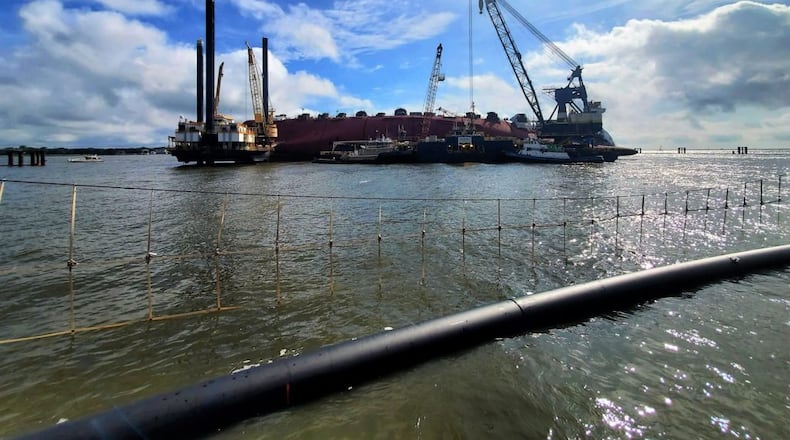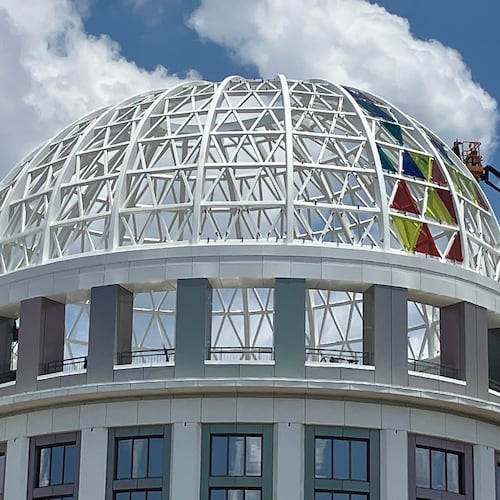The porch at Brogan’s South, a casual, family-friendly restaurant and pub in St. Simons, offers some of the best ocean views on the island. For the past year, part of that view has included a 656-foot car carrier sitting on its side in St. Simons Sound.
“It is not so much of an eyesore anymore,” said Ben Stalvey, manager of Brogan’s South. “We have gotten so used to it being around. Really, it has become just another thing.” Stalvey said it may have even boosted summer business slowed by COVID-19, offering guests a view of the action. Right after the incident, the restaurant offered up a Golden Ray hoagie on the menu.
Now they are just waiting for the ship to be removed. “It is something that we would say was fun while it lasted, but we won’t be sorry to see it go,” Stalvey said.
Credit: George Mathis/AJC
Credit: George Mathis/AJC
In late July, operations to cut and lift the ship from the water were halted for a number of reasons, including COVID-19 and other delays that pushed the salvage closer to hurricane season, said U.S. Coast Guard Petty Officer 2nd Class Michael Himes. While the current target period for removal is the first week of October, Himes said that too is subject to change.
The longer the ship remains in the water, the more locals grow concerned about environmental impacts and problems that may arise during an above-active hurricane season. Many have expressed concerns about the lack of communication from officials with updates on the removal plans.
“We thought, what is the worst that can happen? The worst would be that the ship could leak oil, that it would still be there during hurricane season, that they will cut it vertically and the ship will fall apart in the sound,” said Megan Desrosiers, president and CEO of One Hundred Miles, an organization dedicated to elevating the Georgia coast to a place recognized for its historical, cultural and biological significance. “All of those things are what it is coming to be.”
No one could have predicted that just 30 minutes after the Golden Ray left the Port of Brunswick in the early morning hours of Sept. 8, 2019, with its cargo of more than 4,000 vehicles, the massive vessel would tip sideways and come to rest on the bottom of the sound. All 24 crew members survived with four being rescued from the capsized boat. Then came the challenge of removing the ship from the water and trying to minimize damage to the environment while authorities launched an investigation to determine exactly what happened.
There may have been a fire on board. There may have been stability issues. The grounding may have been intentional or accidental. The Atlanta Journal-Constitution contacted the U.S. Coast Guard and the National Transportation Safety Board for additional information on the investigation, but officials for both agencies said incident reports won’t be released until the investigation has been completed.
Credit: Georgia Department of Natural Resources, U.S. Coast Guard
Credit: Georgia Department of Natural Resources, U.S. Coast Guard
Last year, Tradewinds, an international shipping magazine, estimated the accident could cost the ship’s insurer between $70 million and $80 million. Cargo is insured separately and may add up to $80 million to the claim. Costs for the initial emergency response and pollution control are the responsibility of ship owners. Past marine incidents involving car carriers have taken months and sometimes years to resolve, but locals in the St. Simons area are concerned that officials are not properly addressing or investigating the environmental impact of the Golden Ray.
“The water is the bread and butter of St. Simons Island and the Golden Isles. People come because it is beautiful and pristine and wild,” Desrosiers said. “I know this is one ship and not the Exxon Valdez oil spill, but if we can’t clean up one ship, how do we know that future disasters are going to be handled properly?”
TJ Cheek, a fishing guide for Georgia Fishing Company, is worried about the redfish that spawn in and around the inlet during September and October. “When they come in from off shore to spawn and the loudest thing that has ever been in the water is there, are they going to go somewhere else or skip a year? Does anyone know or care what is going to happen to the red drum?” he asked.
Cheek said already the fishing business has suffered because potential customers were worried that oil from the ship would make any fish inedible.
In the early days of the salvage, responders set up an absorbent barrier around the ship to contain oil as they worked for weeks to remove more than 300,000 gallons from 26 fuel tanks on the ship. That does not include the fuel and fluids in the thousands of cars carried as cargo, which currently remain on the ship and could pose additional environmental concerns during the ship cutting. The barrier now extends across 34 acres around the site along with net panels to catch any debris, said officials with Unified Command, which includes the U.S. Coast Guard, state officials, Gallagher Marine Systems and other partners.
When salvors determined the ship could not be righted and moved, plans for removing the ship included stabilizing it and cutting it into pieces. A specially designed crane for cutting will be moved to St. Simons Sound when the removal begins, a process that is expected to last for eight weeks. Once cut, eight sections will be lifted onto a barge and transported to a facility for recycling.
As they wait to begin removal, crews continue to monitor the ship’s stability and pollution releases and are conducting safety drills while minimizing workers’ exposure to COVID-19, said Himes.
Cheston Broomell, owner of Broomelli Boys Pizzeria in Brunswick, said he hopes future plans also include more transparency with the community. “When a massive saw is going through metal and everything inside it, there is no way of knowing what ... petroleum products are coming out of it,” Broomell said. “It is a huge concern when we talk about remediation ... without any proof or anyone recording what environmental damage has been done, I don’t think the community will be properly compensated.”
About the Author
Keep Reading
The Latest
Featured







